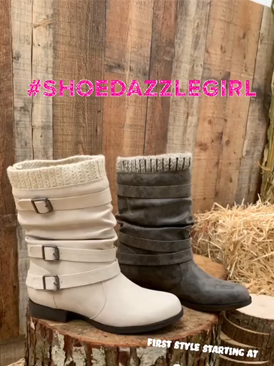Once a business wins a big, lucrative audience, the next challenge is to keep their attention.
TechStyle Fashion Group optimizes its resources to create content for multiple high-earning DTC brands – including JustFab, ShoeDazzle, Fabletics, FabKids and Savage X Fenty by Rihanna.
To engage customers and guide them to future purchases, they use a sophisticated email program equipped with subtle personal touches and inspiring triggers.
To grow digital awareness and increase their following, TechStyle’s paid social media team spearheads content creation by users and in-house staff.
Across its brands, they run over 700,000 ads on Facebook and Instagram per year. How can they fill this demand for content?
User-generated content (UGC) serves two major functions in creating meaningful content at scale. First, it leverages the creative powers of passionate brand enthusiasts to meet the high demand for content. Secondly, it repositions products in a natural environment that makes purchasing more believable for shoppers.
Content blitz for boot season
As with any marketing program or ad campaign, brands achieve success by tracking what works in front of their audience and attempting to carry out similar efforts in the future.
Earlier this year, TechStyle launched a content blitz called “March-Adness,” a first-time experiment that generated over 500 ads featuring UGC.
Earlier this month, the fashion company sought to replicate this success with a new event staged at their corporate headquarters in El Segundo, California.
Aubrie Richey, vice president, media & acquisition, social & influencers, told me that TechStyle received 200 official entries and collected more than 600 pieces of additional content from the new event, dubbed “AdFest.”
Working closely with social commerce platform Curalate, the new content began flighting through paid social channels and display placements last week. Although the content is timed currently with the company’s lucrative boots season, it will continue to run over the next three months, as leaves and snow pile up around many regions in the U.S.
The company aims at not only duplicating the effort from last spring, but tweaking and improving it as well.
“As successful as ‘March-Adness’ was, it was our first event of this kind, and we learned a lot,” Richey explained. “At the time, IG Stories (on Instagram), as an ad placement, were still fairly new – so we knew we had to seize the opportunity to take advantage of the low CPM’s. Unfortunately, the creative our teams were making didn’t feel endemic to the Stories format… and so was born, March-Adness. We were able to leverage and launch content from that event across other placements as well, but it was a bit more constrained given the vertical-only, and in-app shooting of most of the content.”
Passionate content inspired by log boot and other prompts
To inspire the new content, the paid social team refocused on best video practices for the Instagram Stories format. Additionally, they used a now famous ad prompt for boots season – a “log boot” station where boots could be modeled on the familiar woody studio prop.
“This year,” Richey stated, “we armed everyone with new tips and tricks for shooting better quality and more diverse content. We were able to leverage three of our in-house studios to create many more vignettes representing both fall and winter seasons as well as our iconic log-boot station and hot pink ShoeDazzle glitter wall.
She added, “In addition to generating tons of content for our biggest season of the year (boots season), these events have been a great way to educate our teams about our customer acquisition and media efforts, and participation and engagement has been some of the highest we’ve seen at company-wide events.”
Apu Gupta, Curalate’s co-founder and CEO, told me, “Among many things Techstyle is doing, one of the most interesting strategies is about using lifestyle content in ads. They are renowned for their paid media program, and it seems like they got it down to a science.”
According to Gupta, advertisers traditionally use product shots on white or neutral backgrounds to present a more clinical view of what’s on offer. Events like AdFest generate more informal UGC creative that situates products in useful contexts. This approachability leads to revenue.
“The benefit of UGC or other social in that environment is conversion,” he stated. “UGC brings inspiration into that environment and convinces people to check out (buy products). They average a 140 percent increase in conversion using this content.”







